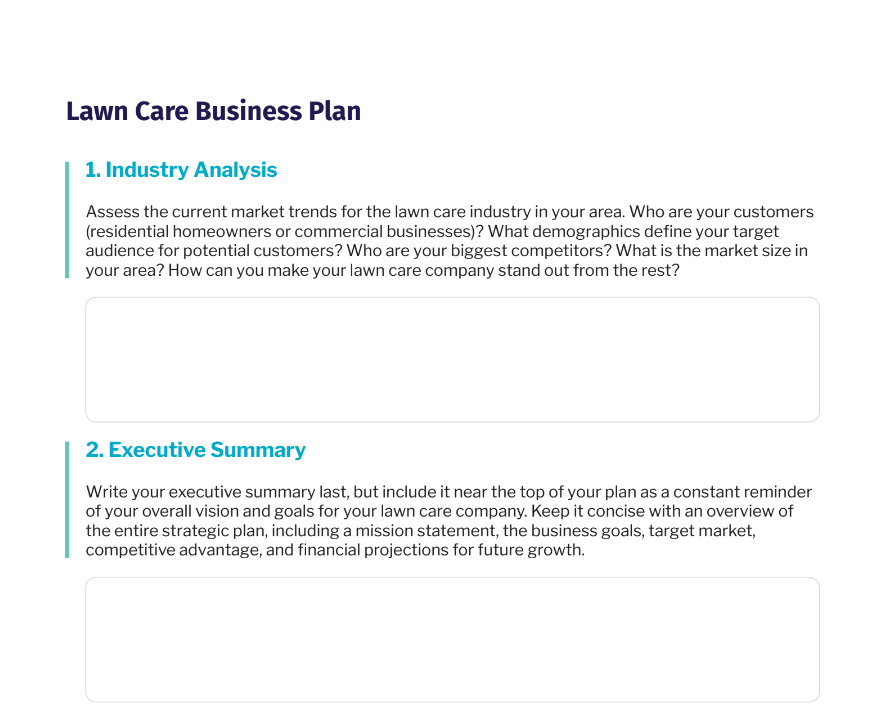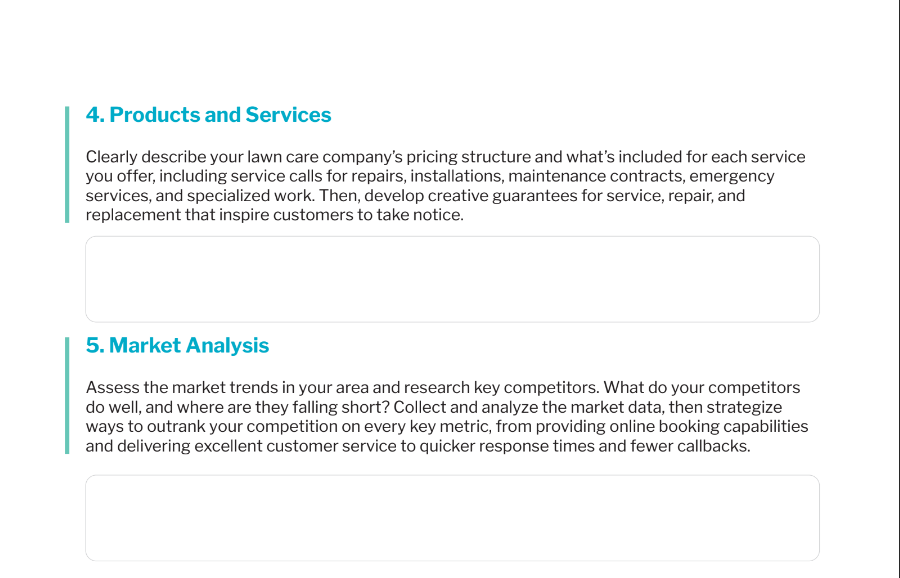Lawn Care Business Plan Template (+Free PDF Download)
Think of a lawn care business plan as a blueprint to help you build a thriving business.
A business plan identifies strategies and guides your decisions for efficient operations, effective marketing, and sustainable finances. It defines company goals and the actions you’ll take to reach them.
Entrepreneurs seeking funding to help run their lawn care businesses rely on business plans to demonstrate to lenders how they’ll achieve profitable results.
Download this lawn care business plan template to launch your startup successfully or boost lawn care company growth.
What Should a Great Lawn Care Business Plan Include?
Effective lawn service business plans look professional, are clearly organized, and are well-written. Here’s a step-by-step look at each section to help you craft an original and compelling business plan.
1. Executive Summary
The one- to two-page executive summary functions as an overview of your business plan. It’s easier to write this section last, after you’ve completed your business plan.
An executive summary provides a synopsis of your entire business plan. It should include:
Mission statement: Explain your company’s purpose and mission.
Services: Describe the business model of your lawn care and landscaping company’s services and competitive pricing strategies.
Market: Mention your target market, how your company meets a need, and niche offerings that set your company apart from the competition.
Financial projections: Summarize your financials and how you plan to achieve financial goals, especially in the first year.

If you’re applying for a business loan, this is the place to state the amount you seek, how you will use the funds, and the steps you’ll take to create a successful lawn care business.
2. Company Overview
A company overview provides a snapshot of who you are, why you’re in the lawn maintenance business, and your growth goals.
The company summary shares key information about your business, including:
Small business owners and founders
Type of business entity, such as sole proprietorship, partnership, or limited liability company (LLC)
History of how the business began
Company vision and core values
Locations and service areas
Number of landscaping business employees or the plan to hire employees
In this section, highlight your company’s strengths. Mention the business owners’ years of experience and certifications in the landscaping industry. Include other awards, achievements, or community recognition.
Lastly, share your your company goals and how you plan to grow. This will show potential investors that you have the knowledge and ambition to drive your company forward.
3. Lawn Care Services
In this section of your lawn mowing business plan, you’ll detail your services and how they differentiate you from competitors.
Explain lawn care services and lawn maintenance service plans, such as:
Basic, full, and premium service plans
Lawn mowing
Lawn trimming and edging
Bed maintenance
Shrub or tree trimming
Debris removal
Mulching
Fertilization of turf, beds, shrubs, or trees
Pest control in turf and beds
Weed control
Other landscaping services, such as planting flowers, leaf removal, or snow removal
Highlight unique services not offered by competitors. This could also include using software, such as FieldRoutes® lawn care software, which elevates the quality of your work and improves customer service.
4. Lawn Care Pricing
Your pricing structure determines the profitability of your business. Price too low, and you won’t cover expenses. Too high, and you’ll price yourself out of a job.
Before determining prices, calculate the costs of your lawn care business. You’ll need to factor in direct and indirect costs, like labor, equipment, and overhead expenses. Your prices also need to include a profit margin percentage.
Common lawn service pricing models include:
Per-Service Pricing: This is a straightforward approach. You set a price for each service offered, like mowing, edging, or aeration. Customers easily understand upfront costs.
Square Footage Pricing: This model bases the price on the lawn size or property being serviced. It works well for simple services like mowing, where lawn size directly affects time spent. Prices are typically quoted per square foot or acre.
Hourly Rate: This method charges customers based on your crew's total time on the property. It's suitable for complex projects or those requiring unforeseen adjustments. Be sure to communicate your hourly rate.
Custom Quote: This option provides a personalized estimate considering the specific service(s) requested, property size, and estimated crew time. It offers flexibility for unique customer needs but requires more upfront effort for each quote.
As you determine prices, consider what your target market will pay and how it compares to competitors. Periodically reevaluate your pricing to ensure your company meets financial goals.
5. Market Analysis
A market analysis helps you define and understand potential customers. Why is this so important? You want to deliver the right service at the right price.
A market analysis evaluates:
Lawn care industry outlook and trends
Total market size
Target market demographics, such as homeowner age, marital status, income level, habits, and needs.
Service demand
Market growth potential
Lawn care business owners can unearth this information through online research, customer surveys, or social media feedback.
Uncover opportunities for potential growth, such as partnering with real estate agents, property managers, or vacation rental owners to provide lawn care services.
Use graphs and tables to present your data visually. Visual presentations look professional and communicate complex information easily and quickly.
6. Competitor Analysis
A competitor analysis identifies the competitors in your market. It helps you understand the services and prices of other local businesses providing lawn care so you can position and promote your businesses competitively.
To perform a competitor analysis:
Examine competitor services, service areas, prices, marketing share, customer ratings and reviews, marketing strategies, and online presence.
Specify your company’s strengths and weaknesses. This could include quality of service, unique services, and pricing strategies. Mention potential barriers and how you will overcome them.
Identify where your company can fill in service voids, find a new segment of customers, or improve pricing and marketing strategies.
Analyzing your competitors helps you improve the quality of your services, identify profitable opportunities, and strengthen your competitive edge.
7. Marketing and Sales Strategy
Marketing and sales strategies attract new customers to grow the business.
A marketing plan details strategies for reaching your target market and includes marketing objectives, budgets, and methods for measuring performance.
Effective lawn care marketing strategies include:
Offline marketing: Generate leads through business cards and direct mail.
Digital marketing: Connect with customers through email marketing, social media marketing, search engine optimization (SEO), and pay-per-click (PPC) advertising.

FieldRoutes Software provides fully integrated marketing automation tools through ServiceTitan Marketing Pro. Using these tools, lawn care professionals can quickly build email and direct mail campaigns, grow revenue, and measure campaign performance.
Sales strategies result in increased revenue through upselling strategies or gaining new customers. Top lawn care sales strategies include:
Upselling services: Package services or promote special deals to encourage customers to add on services.
Seasonal discounts: Attract new customers with seasonal discounts.
Referral programs: Incentivize customer referrals to boost word-of-mouth recommendations.
FieldRoutes mobile app helps lawn care companies manage their sales pipeline, provide tools for techs to upsell services, and evaluate sales performance.
8. Management Plan
A management plan outlines your company's management structure and operational processes.
The plan includes your management team's structure, roles, and how your team’s strengths contribute to business success. It also includes your team’s qualifications and skill sets.
Describe the details of the business, including days and hours of operations. Include your workflow processes to demonstrate a seamless operation to investors.
FieldRoutes lawn care business software helps you save time and work more efficiently with centralized data, optimized scheduling and routing, digital property estimation, and customer service tools.
With user profiles, permissions, and role-based reporting, FieldRoutes allows your team to easily access job and sales details to improve performance.
9. Financial Plan
A financial plan provides a financial overview and projects future business revenue. Investors will scrutinize your financial plan, so accurate and realistic numbers are essential.
If you’re just beginning, your financial plan must include startup costs. Startup costs could include:
Business licenses
Legal fees
Equipment such as mowers and trimmers
Vehicles and trailers
Next, you’ll need to calculate ongoing operating expenses. This includes:
Employee payroll
Business and vehicle insurance
Fuel
Equipment maintenance
Bookkeeping costs
Lawn care software subscriptions
If you’re already in business, you must provide lenders with three to five years of financial information. You’ll need to show projected expenses and revenue if you're just starting out.
Use these financial statements to create a financial projection:
Income statement or profit and loss (P&L) statement: An income statement shows company income and expenses for one year. This statement shows the financial performance of your company.
Cash flow statement: A cash flow statement projects incoming and outgoing expenses for one year. It shows where money comes from and how your company spends it.
Balance sheet: A balance sheet lists business assets and liabilities. It shows the debt-to-equity ratio and indicates a company's financial health.
How to Secure Financing for a Lawn Care Business
Lawn care professionals seek funding to start or grow their businesses. The type of funding depends on your financial health and your business needs.
To secure financing, follow these steps:
Identify your needs
Create a detailed business plan
Determine funding qualifications
Apply for funding
Budget to repay funds
Business funding options could include:
Traditional business loans through banks
Partners or investors
Business line of credit
In any scenario, lenders will require a business plan to see the viability of your business. A thorough business plan demonstrates the value of your company to potential investors.
Launch Your Lawn Care Business the Right Way
Starting your own lawn care business is a big undertaking. A business plan can help you determine the details and obtain the needed funding.
To start your business right, choose FieldRoutes lawn care software to work more efficiently, improve customer service, and increase profit.
FieldRoutes provides the tools for lawn care professionals to streamline every aspect of service, from optimized routing and automated appointment reminders to on-site contract approval and online credit card payments. These time-saving solutions allow you to focus on what matters most—growing your business.
Schedule a demo to see how FieldRoutes boosts business.